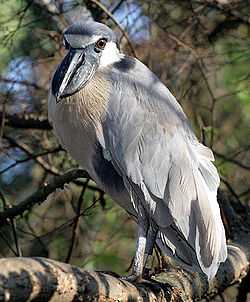Boat-billed heron
| Boat-billed heron | |
|---|---|
 | |
| Conservation status | |
| Scientific classification | |
| Kingdom: | Animalia |
| Phylum: | Chordata |
| Class: | Aves |
| Order: | Pelecaniformes |
| Family: | Ardeidae |
| Genus: | Cochlearius Brisson, 1760 |
| Species: | C. cochlearius |
| Binomial name | |
| Cochlearius cochlearius Linnaeus, 1766 | |
The boat-billed heron (Cochlearius cochlearius) - colloquially known as the boatbill - is an atypical member of the heron family, and was formerly thought to be in a monotypic family, Cochlearidae. It lives in mangrove swamps from Mexico south to Peru and Brazil. It is a nocturnal bird, and breeds semi-colonially in mangrove trees, laying 2-4 bluish white eggs in a twig nest.
The boat-billed heron is about 54 cm long. The adult has a black crown, long crest and upper back. The face, throat and breast are white, and the lower underparts are rufous with black flanks. The wings and lower back are pale grey. The massive broad scoop-like bill, which gives rise to this species' name, is mainly black. Immature birds have mainly brown upperparts and brown-tinged whitish underparts, and lack the crest.
This species feeds on fish, rodents, eggs, crustaceans, insects and amphibians. Its calls include a deep croak and a high-pitched pee-pee-pee.
References
Notes
- ↑ BirdLife International (2012). "Cochlearius cochlearius". IUCN Red List of Threatened Species. Version 2013.2. International Union for Conservation of Nature. Retrieved 26 November 2013.
Bibliography
- Hilty, Steven L (2003). Birds of Venezuela. London: Christopher Helm. ISBN 0-7136-6418-5.
- ffrench, Richard (1991). A Guide to the Birds of Trinidad and Tobago (2nd edition ed.). Comstock Publishing. ISBN 0-8014-9792-2.
- A guide to the birds of Costa Rica by Stiles and Skutch ISBN 0-8014-9600-4
External links
 Media related to Cochlearius cochlearius at Wikimedia Commons
Media related to Cochlearius cochlearius at Wikimedia Commons- Photos of the boat-billed heron
